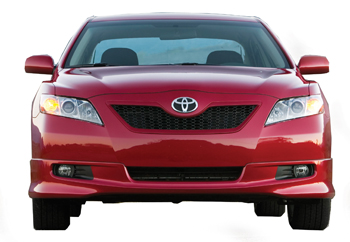
 In 2007, Toyota introduced a new Camry that was larger. But, under the new sheet metal was the same suspension design that was on the previous model.
In 2007, Toyota introduced a new Camry that was larger. But, under the new sheet metal was the same suspension design that was on the previous model.
The suspension on the Camry is nothing special and has no real quirks. The only shocker is that the front caster is non-adjustable and there are no special kits or tools to alter the caster angle. If the caster when compared side-to-side is greater than .75º, chances are that the lower control arm has been damaged.
Toyota designed the control arm on the Camry to absorb and deform during impacts so the body and suspension cradle will not be damaged. Replacement control arms are readily available for this vehicle. Pay attention to the included angle or SAI. This diagnostic angle can help you determine if the control arm or knuckle has been damaged.
On 2007 and 2008 models, some drivers may experience a “flutter” at highway speeds due to the front hub wheel bearings according to TSB 0106-08. In order to diagnosis the problem, it is essential to rule out the wheel assembly using a tire balancer that can minimize radial force variation.
The rear suspension uses a strut with one trailing link and two lateral links. The main area of wear is on the bushings. Worn bushings can produce uneven tire wear by changing the camber and toe. Camber can be adjusted with aftermarket cam bolts. Even negative camber on both sides exceeding 2º can indicate worn or broken springs.
Rear toe adjustments should be performed using both lateral links on each side. Toyota has set a specification that says the links should be within 1.5mm in length of each other. The toe angles on both sides should be close to equal. One turn of each adjusting tube will adjust toe-in by approximately 1.2°(1°12′), 10.8 mm (0.425 inch).
If you are replacing the rear struts, pay special attention to the upper strut mounts. If you do not take care to insulate the upper strut mount from the body, the customer may come back complaining of a ticking noise in the rear. The solution recommended by Toyota is to apply foam tape to the three surfaces of the strut mount.
Electronics
All 2007-2010 Camry models are equipped with an optional Vehicle Stability Control (VSC) system that requires a scan tool and special procedure to perform a zero point calibration of the steering angle sensor. It is highly recommended to do this through the OBDII port. A scan tool can be used or Hunter’s CodeLink tool which is programmed to address Toyota’s requirements relative to the VSC zero point calibration. Hunter has simplified the process with a seamless transition from the final front toe adjustment to the required reset. Yes, it is possible to reset the system by jumping two pins in the diagnostic connector and disconnecting the battery. But, there is no way to confirm or document the calibration was properly performed.
The steering position sensor’s basic function is to monitor the driver’s steering inputs. This includes the angle of the steering wheel and/or the rate at which the driver is turning the wheel. The steering position sensor on the Camry is located behind the steering wheel and is a high-resolution sensor.
The VSC system relies on accurate steering input from the steering angle sensor to analyze a situation and apply appropriate measures to help direct the vehicle on the intended path. If the system if not calibrated after a toe adjustment, the system will not operate properly and may illuminate the VSC malfunction light after the driver has picked up their Camry.
The Toyota VSC system uses the information from the steering position sensor and compares the information to the yaw rate sensor to determine what the car is doing.
When a vehicle is aligned and the toe in the front or rear is altered, it changes the thrust angle of the vehicle. The thrust angle is directly connected with the slip angle and the measurements taken by the yaw position sensor. Even if you adjust only the rear toe, you are altering the thrust angle and the steering position sensor must be recalibrated.
TPMS
The direct TPMS system for Toyota vehicles uses a button labeled “SET” below the steering column or in the glove box to reset the system. When you press the button, the system is looking for the sensor IDs that are already stored in the memory.
Reset Procedure
1. Park the vehicle in a safe place and turn the ignition switch to the “LOCK” position.
2. Adjust the pressure of all installed tires to the specified cold tire inflation pressure level.
3. Turn the ignition key to the “ON” position.
4. Push and hold the tire pressure warning reset switch until the tire pressure warning light blinks slowly three times.
5. Leave the system with the ignition switch in “ON” position for a few minutes, and then turn the ignition key to the “LOCK” position.
Typically, systems use a light on the dash and do not display individual pressures (2010 models display pressures in the drive information). When the vehicle is started, the light should illuminate for three seconds and go out if the system is functioning normally. If the light stays on, it means that the system has detected a low tire. The inflation of all the tires (sometimes including the spare) should be checked.
If the light flashes for one minute after the ignition is turned on or continues to flash, it is a sign the system has a malfunction that needs to be diagnosed. On some models, the frequency and length of the flashes can be used to diagnose a problem.
The “SET button” procedure should be used when rotating tires that have different tire pressures in the front and rear, changing or adjusting the tire pressure, or changing tire size, or when tires are replaced.
If you push the button while the vehicle is moving, initialization is not performed. If you push the tire pressure reset switch accidentally and initialization is performed, adjust the tire inflation pressure to the specified level and initialize the system again.
If the tire pressure warning light does not blink slowly three times when you push and hold the reset switch, initialization has failed and the tire pressure warning system may not work properly. In this case, you will need to initialize the system again.
If there is a problem with one or more of the sensors communicating with the TPMS module during the reset procedure, it could go into a “looping” mode where it locks out the use of the SET button and the TPMS light will flash. The system is now stuck in this looping mode, and no matter how many times you press the SET button or cycle the ignition, the light will continue to flash.
The only way to stop the looping and the system from looking for sensor IDs not in the memory is to perform a procedure that puts the system into a “learn mode” (see “Stuck in a Loop”).












